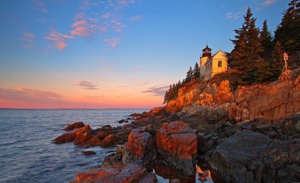Editor's note: Throughout the summer we'll be featuring national park friends groups from around the country to highlight the value they bring to the National Park System. Friends of Acadia has been working since 1986 to bring a measure of excellence to Acadia National Park. This is their story.
Acadia in 1919 became the first national park east of the Mississippi. Thanks to people with a passionate love for the beauty of Mount Desert Island— and its cool summers (at least compared to inner-city Boston and New York City)— the jewel dubbed “MDI” was spared from rampant development.
One visit to Mount Desert Island, its surrounding waters, and outlying islands is all it takes to understand why those early Acadia aficionados so deeply appreciated the area that they made preservation a possibility. They created Village Improvement Associations that cut trails through the woods and around the ponds, installed those iron rungs in cliffsides, and built stone steps to make exploration easier.
Friends of Acadia continues that longstanding tradition of inspiring and connecting private partners for the public good. This all important theme is reflected in the upkeep of Acadia’s carriage roads and its hiking trails, its clean-powered shuttle system, and even the further protection of private lands in and adjacent to the park.

“Acadia National Park was created through a unique public/private partnership: many, many gifts of land, large and small, from individuals who love this place were given to the American people to make up Acadia,” notes Aimee Beal Church, the non-profit organization’s communications and outreach coordinator. “Friends of Acadia builds on this tradition by working with governmental and non-governmental organizations, individuals, communities, clubs and groups.”
The friends group has raised $3.4 million to maintain the beautiful and peaceful 45-mile-long carriage road system that Mr. Rockefeller had built on Mount Desert Island. Since 2000 it also has raised $13 million for Acadia Trails Forever, the country’s first endowed hiking trail system.
Through an agreement with L.L. Bean, Friends of Acadia also garnered $3.25 million to underwrite the Island Explorer, a propane-powered fleet of 30 shuttle buses that loop the park, enabling visitors to be car-free once they reach Mount Desert Island. And Friends leverages enough dollars to support nearly 150 jobs in the park each summer.

Bass Harbor Light at sunrise, Michael Rickard photo.
The theme of partnering has enabled Friends of Acadia to recruit area volunteers to perform maintenance on the park’s trail and carriage road system. A novel idea also brings high school students into the park. The organization’s Acadia Youth Technology Team brainstorms the role of technology in the park and explores how today’s electronic tablets or smartphones can nurture and inform the next generation of park stewards without obscuring the raw beauty of Acadia.
Looking ahead, Friends of Acadia is building upon the Acadia Youth Technology Team’s efforts to grow the ranks of park advocates, and is continuing to develop the Acadia Gateway Center, a planned welcome center for park visitors with a maintenance shop for Island Explorer buses. With the park’s 2016 centennial coming the same year that the National Park Service marks its centennial—President Wilson christened what’s now Acadia as the Sieur de Monts National Monument in 1916—the friends group is developing initiatives for that celebration.

You can explore the carriage roads in Acadia via horse-drawn wagon. NPS photo by Ray Radigan.
Friends of Acadia does more than just build on the vision that Acadia’s founders had for this special place. Whether it’s keeping the Island Explorer fleet running, turning today’s youth into tomorrow’s park stewards, or advocating for the park before Congress, Friends builds on a treasured philanthropic tradition of private citizens who gave their summer place to future generations of a grateful public.
Coming Sunday on the Traveler: Insider tips from Friends of Acadia for exploring Acadia National Park.
Coming next Wednesday: Friends of Big Bend, Looking Forward While Preserving The Past


 Support Essential Coverage of Essential Places
Support Essential Coverage of Essential Places






